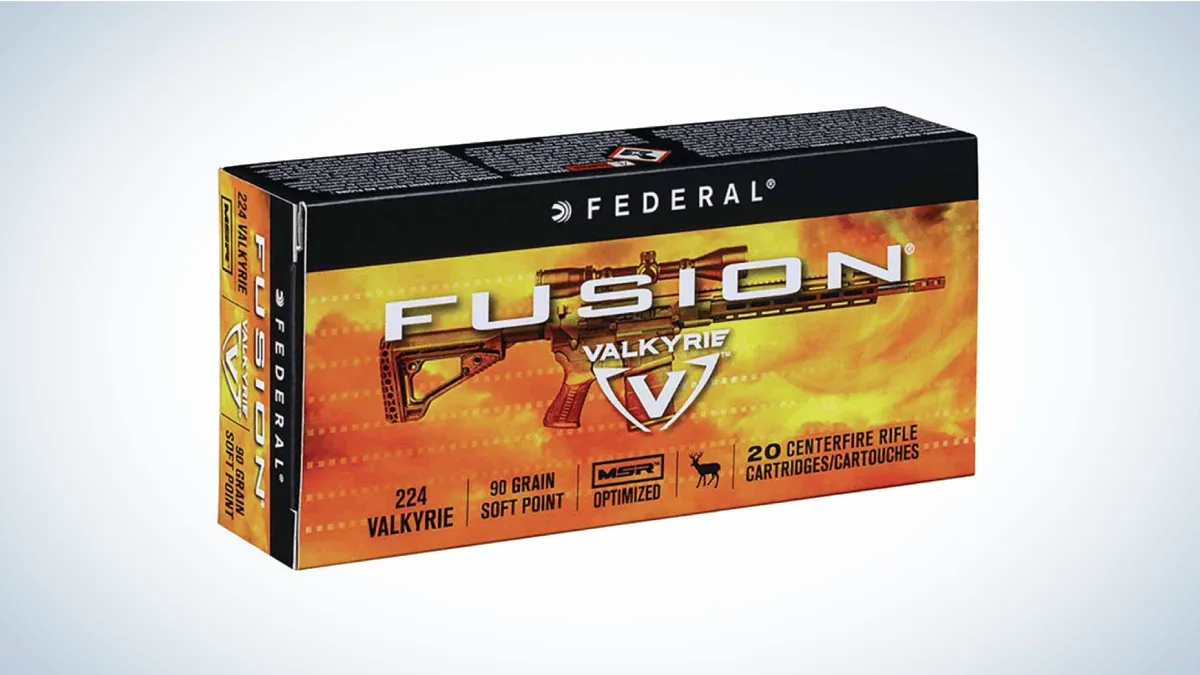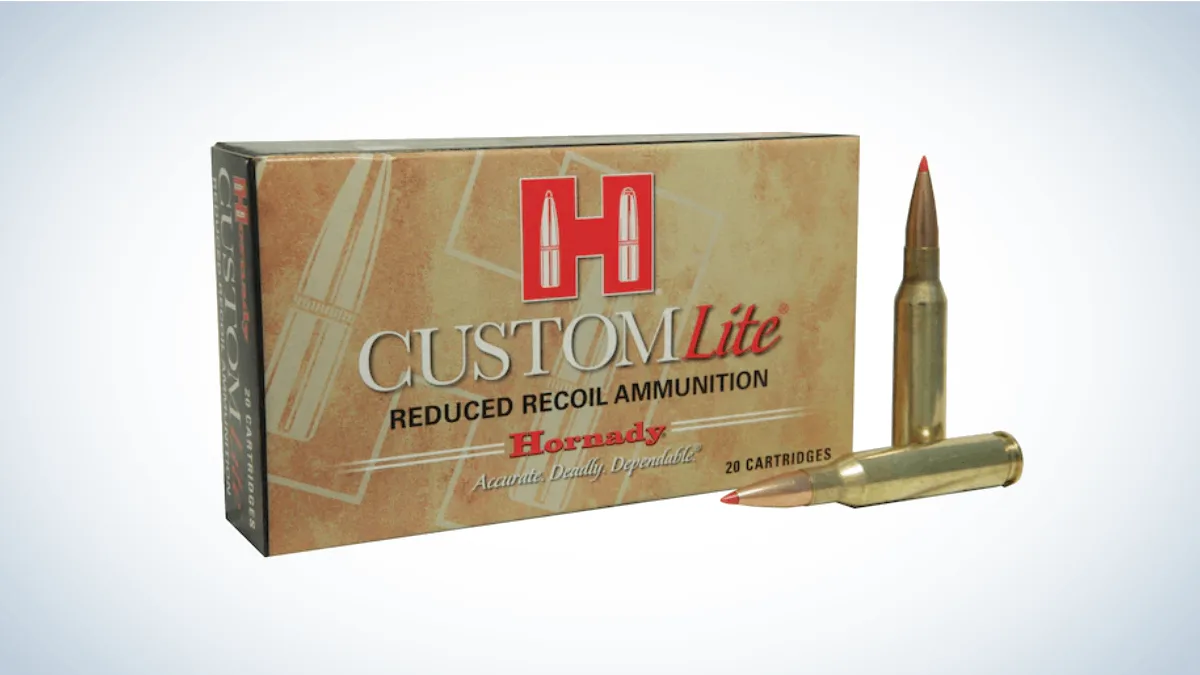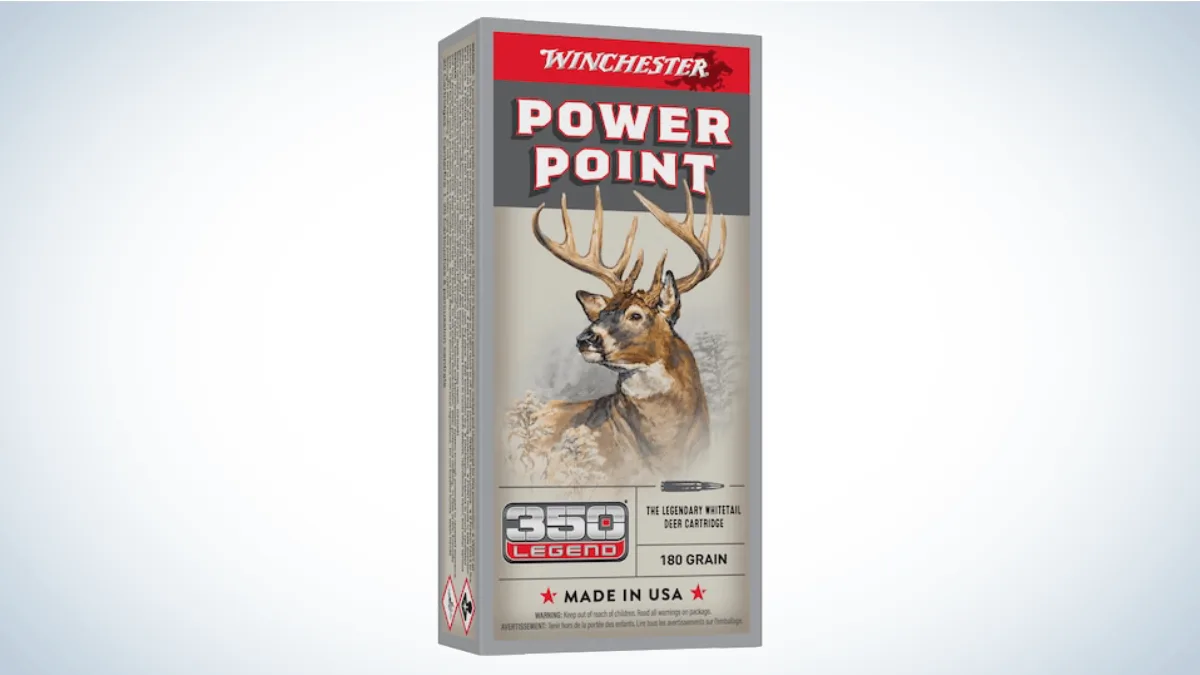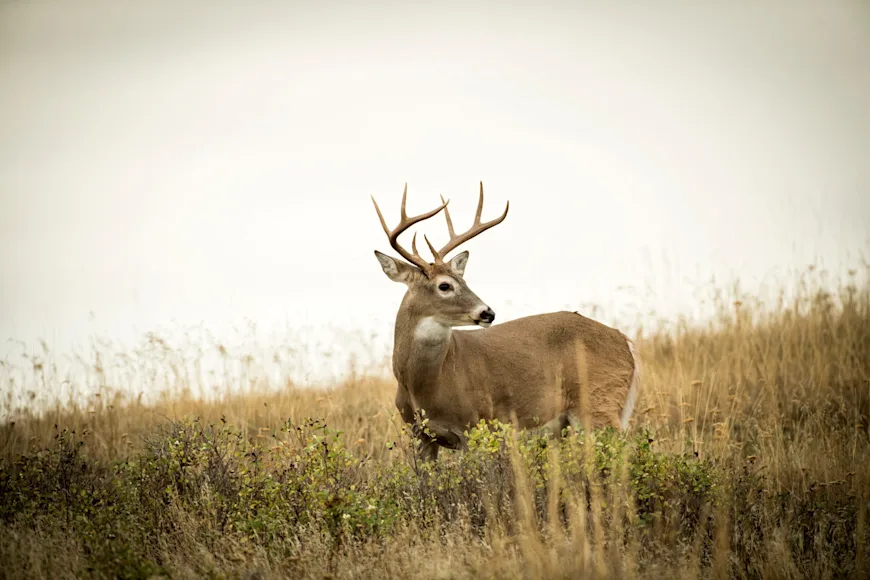We may earn revenue from the products available on this page and participate in affiliate programs. Learn more ›
_
The problem with finding a low-recoil deer rifle and cartridge is that recoil tolerance is very subjective. I’ve seen people as thin as a poor man’s wallet shoot elephant guns without issue, and I’ve seen guys who could moonlight as sumo wrestlers flinch with every .223 Remington round they pushed down range. There are also many people who, due to medical limitations, must shoot low-recoil deer rifles.
The weight of the gun, bullet weight, powder charge weight, and muzzle velocity are primary factors that influence perceived recoil. In guns of equal weight, the greater the bullet weight and the heavier the powder charge, the greater the recoil. Simple, right? Not quite.
Stock configuration plays a role because a stock with too much drop at comb and heel can kick harder than an angry zebra. Also, keep in mind that cartridges that are mild to shoot in a rifle weighing 8½ pounds may be too much to bear in an ultralight rifle. And, you can shoot hotter loads more comfortably in a semi-auto than you can with a bolt-action in the same chambering. Semi-autos tend to spread recoil impulse over a longer period of time, lessening perceived recoil, and good recoil pads also mitigate kick, as can heavy winter clothing.
You can easily find a rifle recoil chart or use an online recoil calculator. Both approaches require you to know the weight of the powder charge. Ammo makers don’t typically publish that information, but you can get a good idea by looking at recommendations in reloading manuals. We’ve made it easy for you by a picking a dozen great deer cartridges for recoil-averse hunters—rounds which, when used with rifles of reasonable heft, produce recoil below the 15 foot-pounds/15 feet-per-second threshold with most standard loads. Don’t fret if your favorite isn’t on the list. There are simply too many good cartridges to list here, and cartridge choice, like recoil tolerance, is highly subjective. Here are some of our soft-kicking favorites for putting venison in the freezer.
The Best Cartridges for Low Recoil Deer Rifles
.223 Remington
.224 Valkyrie
.243 Winchester
.257 Roberts
.25-06 Remington
.260 Remington
6.5×55 Swedish
6.5 Creedmoor
6.8 Remington SPC
7mm-08 Remington
.30-30 Winchester
350 Legend
1. .223 Remington

Many states do not allow .22 centerfire cartridges for deer hunting, so if you hunt in one of these states, you might want to skip ahead to some of our other picks. Of course, some of these no-22 states are shotgun-only states or, at most, permit the use of straight-walled cartridges for hunting deer. Prohibitions against using .22 centerfire cartridges for deer hunting stem mostly from a time when ammunition was not nearly as advanced as some of today’s ammo designed specifically for optimal terminal performance on game.
There’s little doubt that the .223 is effective on deer within reasonable ranges—meaning ranges at which a bullet will still have the velocity to sufficiently penetrate and expand—with today’s better bullets. In the eyes of many hunters, however, the .223 remains a marginal choice for deer when so many other proven, mild-recoiling rounds are available.
The .223’s main virtue for deer hunting, particularly with soft-shooting semi-auto rifles, is mild recoil, and the fact that factory ammo loaded with deer-appropriate bullets is widely available.
2. .224 Valkyrie

As one of the newer kids on the block, Federal’s .224 Valkyrie represents a significant step up in performance over the .223 Remington. You won’t find it at every rural pit stop selling ammo, but it’s well worth the effort to look for it. Based on a necked-down .30 Rem./6.8 SPC case, the round was initially developed for the AR platform to take advantage of the superior ballistics of long, streamlined bullets.
The .224 Valkyrie can be deadly on deer-sized game, especially with Federal’s 90 gr. Fusion soft-point load. This little ballistic wonder steps out with a muzzle velocity of 2,700 fps and a muzzle energy of around 1,450 foot-pounds. Energy doesn’t drop below 800 foot-pounds until the round is about 350 yards downrange.
Of course, deer don’t read ballistic energy charts and are unlikely to complain that the round that killed them was lacking in theoretical killing power. Far more important factors are bullet construction and bullet placement, and the .224 Valkyrie’s combination of reach and mild recoil contribute to accurate bullet placement, especially when launched from barrels of 20 inches or more to take advantage of the round’s speed. Recoil is cheerfully minimal. Out of a 9½ pound semi-auto rifle, the 90 gr. Fusion load generates less than 4½ foot-pounds of recoil energy.
**Read Next: 11 Best Cartridges for Whitetail Deer**
3. .243 Winchester

Mention the words “mild recoil” and “deer rifle” in the same sentence, and experienced hunters will immediately talk about the .243 Winchester. There are very good reasons for this, including the fact that an 8-pound rifle launching a 100-grain bullet at speeds approaching 3,000 fps will generate less than 9 foot-pounds of recoil energy.
When the cartridge made its commercial appearance more than 60 years ago, one of its claims to fame was that it was equally well-suited for potting varmints with lighter bullets and taking deer with bullets in the 95- to 105-grain range. The fact that it did so with manifestly mild manners earned the cartridge a lasting reputation as a great “starter” round for kids and people of small stature—or for anyone who preferred to shoot softer-kicking rifles.
There are other 6mm cartridges competing for attention, but none will make deer any deader than the old workhorse .243, which, like so many successful cartridges, is based on a necked-down .308 Win. case. The 6mm Creedmoor gets the nod for competition shooting, and the 6mm Remington will perform well in the field, but neither of these is offered in nearly as many rifle models and factory ammo loadings as the .243. Plain cup-and-core bullets will still get the job done, and there’s no shortage of factory loads using upgraded, proven performers like the Barnes TTSX, Nosler Partition, and Hornady ELD-X, to name just a few.
4. .257 Roberts

The .257 Bob, as it is affectionately known by its fans, began life as a wildcat but was taken mainstream by Remington, in slightly altered form, in 1934. The cartridge has a reputation as the most gentlemanly of today’s most popular quarter bores with recoil energy remaining at or below 10 foot-pounds with most commercial loads. The round was, at one time, a top seller until the .243 Winchester made its highly successful appearance and stole some of the Bob’s thunder.
There’s no question that the .257 Roberts is effective on deer-sized game, and it wins in the “cartridge snobbery” department, but you may have a hard time finding ammo for it unless you load your own.
Federal no longer loads for the .257 Roberts, and neither does Remington. Hornady still offers a .257 Roberts +P Superformance load with a 117 gr. SST bullet, with a claimed muzzle velocity of 2,945 fps from a 24-inch barrel, and a drop of only 7.3 inches at 300 yards with a 200-yard zero. Winchester still makes a 117 gr. Power-Point load, and HSM offers a varmint load as well as a couple of deer loads, including one with a 117 GameKing bullet and one with a 115 gr. Berger VLD bullet.
5. .25-06 Remington

Some might argue that the .25-06 Remington shouldn’t be on our list. Recoil energy is sneaking up on 13 foot-pounds of energy, with a 120 gr. bullet exiting an 8-pound rifle, and recoil velocity is getting into the “sharp” category. Yes, the .25-06 speaks with some authority—and these levels are approaching the upper limits of comfort for some shooters—but most dedicated quarter-bore fans don’t much care.
Based on a necked-down .30/06 case, the .25-06 is not as potent as the .257 Wby. Mag., but it remains a favorite of Western hunters due to its combination of high kinetic energy, flat trajectory, and tolerable recoil. Consider, for example, the Federal Premium load using a proven game-getter bullet, the 115-grain Nosler Partition. This cartridge launches the bullet at more than 3,000 fps with 2,400 foot-pounds of energy. Zeroed at 200 yards, the bullet drops less than 7 inches at 300 yards and still has nearly 1,400 foot-pounds of energy.
Another plus for the .25-06 is the fact that ammo is widely available from a variety of makers. In the big open country that mule deer and pronghorn call home, the .25-06 remains a great option and, with the right bullets, will take bigger game cleanly.
6. .260 Remington

The .260 Remington began life as a wildcat, based on a necked-down .308 Win. case, used primarily for competition shooting. Remington legitimized it as a factory offering in 1997, but chose, strangely, to name the cartridge something it wasn’t. The .260 Remington does not use .260 diameter bullets. It uses .264-inch, or 6.5mm, bullets. Of course, the round was named well before the 6.5mm craze hit the American shooting scene in full force.
The .260 Remington didn’t quite enjoy the same runaway popularity of the 6.5 Creedmoor, and that’s a shame because it is a mild-recoiling cartridge that can drive high-ballistic-coefficient bullets out of short-action rifles with fine accuracy and good downrange ballistics.
At normal hunting distances, with bullets in the 140-grain weight class, the .260 Remington falls roughly in the middle, performance-wise, between the 6.5 Creedmoor and the 6.5 Swede. That is not a bad place to be. As a point of comparison, a Federal .260 Rem. load using a 140-grain Sierra Game King boat-tail soft-point bullet starts out at about 2,700 fps, has 1,358 foot-pounds of energy at 300 yards, and drops 8.8 inches at that distance assuming a 200-yard zero. Hornady’s 6.5 Creedmoor 143 gr. ELD-X load also has a muzzle velocity of about 2,700 fps, but hits with about 300 more foot-pounds of energy at 300 yards and drops about an inch less. Both will kill deer handily at that distance.
Happily, most major American ammo makers, including Federal, Hornady, Remington, Barnes, and Black Hills, load for the .260 Remington with good 120- to 140-grain hunting bullets.
7. 6.5×55 Swedish

For a cartridge that’s been around for 125 years and began life as a European military round, the 6.5×55 Swede isn’t doing too badly, despite a noticeable lack of factory ammo options compared to more popular 6.5mm brethren. Within the 6.5mm family, the Swede has been a favorite of many handloaders, as American factory ammo was historically loaded on the light side.
The round was always more popular in Europe than in America, but it has its fans in the U.S. thanks to its effectiveness on game, with the proper bullets, and mild recoil of less than 11 foot-pounds of energy in most rifle/ammo combinations.
Today, US ammo makers load 140-grain bullets to a muzzle velocity of a little more than 2,500 fps, with the notable exception of Hornady, which makes a Superformance load that launches a 140-grain SST bullet out of a 24-inch barrel at more than 2,700 fps. With most other factory loads, the Swede pushes bullets slower than the 6.5 Creedmoor, and bullets of the same weight will drop more at 300 yards and beyond. Deer tagged by the Swede are highly unlikely to notice the difference.
8. 6.5 Creedmoor

No other cartridge in recent memory has engendered as much love—and hatred—as the 6.5 Creedmoor. This can be attributed, on one side, to those who proclaimed the 6.5 Creedmoor to be the Holy Grail of extreme-distance hunting cartridges and, on the other, to a certain Fudd faction who assert that anything newer than the .30-06 Springfield is worthless.
What isn’t ridiculous is the 6.5 Creedmoor’s soaring popularity. Virtually every major rifle manufacturer chambers guns, including ARs, for the Creedmoor, and a wide array of factory ammo is readily available.
Introduced by Hornady more than a dozen years ago as a long-range target round, the 6.5 Creedmoor is a more modern cartridge than many of its 6.5 mm siblings by virtue of the fact that it is designed to use quite long, high-ballistic-coefficient bullets. The cartridge proved to be flat-shooting and inherently accurate, with mild recoil, and it didn’t take long for hunters to jump onboard en masse once ammo makers started loading the round with good hunting bullets.
I have been conducting an extended field test of rifles in 6.5 Creedmoor over the past several years and have shot numerous mule deer, whitetails, and hogs (and one unlucky coyote) with rounds using the Hornady 143 gr. ELD-X bullet and the Remington 120-grain Core-Lokt bullet. Terminal performance has been, well, terminal. I wouldn’t hesitate to use 6.5 Creedmoor loads with heavier bullets on elk at reasonable range.
9. 6.8 Remington SPC

The story of the 6.8 Remington SPC (Special Purpose Cartridge) is a tale of two cartridges—the one it started out as, and the one it became. The round was conceived as a military cartridge to provide more lethality than the 5.56 NATO cartridge without giving up much magazine capacity and holding recoil to mild levels.
In military dress, the cartridge had some shortcomings, and ultimately was not adopted, but with continued tweaking of both the cartridge and rifle chambers, the round has steadily gained popularity and is now a darling of those who prefer to hunt with AR-platform guns. Rifle manufacturers and ammo makers noticed, and a wide variety of rifles and factory loads are now available.
Using bullets with the same diameter as the .270 Winchester, the cartridge is definitively more potent than the .223 Remington. Looking at just one factory load, Federal’s Fusion MSR 115-grain cartridge, the bullet starts out at 2,470 fps and has 1,059 foot-pounds of energy at 200 yards. In contrast, Federal’s 60-grain Nosler Partition .223 Remington load has a higher initial muzzle velocity, but only 736 foot-pounds of energy at 200 yards. The 6.8 SPC is not generally regarded as a long-range deer round, however, as velocity and energy drop off quickly past 300 yards.
Still, the turnaround in fortunes for the cartridge has been so dramatic that, today, many fans of the round will tell you that the purpose of the Special Purpose Cartridge is to hunt deer. Given its proven performance in the field, it’s hard to argue with that assertion.
10. 7mm-08 Remington

If you’re looking for one soft-kicking cartridge to do it all—from hunting whitetails to hunting black bear and elk—look no further than the 7mm-08 Remington. The cartridge is based on a .308 Win. case, but with the higher ballistic coefficients of 7mm bullets, it outperforms the .308 in many respects. It also has less recoil than many .308 loads—roughly 13 foot-pounds with a 150-grain bullet in an 8-pound rifle versus nearly 15 foot-pounds for the .308 with the same bullet and rifle weights.
How does it stack up against the .308? Let’s compare two 150-grain loads from Hornady. The 7mm-08 ELD-X load has an advertised muzzle velocity of 2,770 fps. The bullet drops 7.5 inches at 300 yards and 21.6 inches at 400 yards. The 308 SST load has a higher muzzle velocity of 2,820 fps, but drops 7.9 inches at 300 yards and 23.1 inches at 400 yards. That’s a slight advantage to the 7mm-08. The eye-opening part of the comparison is that the 7mm-08 hits with nearly 240 more foot-pounds of energy at 400 yards than the 308 does–and it does so with less recoil.
A quick survey of six major ammunition manufacturers reveals 27 different available loads for the cartridge, with bullets weights ranging from 120 to 150 grains. Handloaders can go heavier or lighter depending on their needs and preferences. Of course, the .308 Win. is available in factory ammo with a greater selection of heavier bullets, but they all come with correspondingly heavier recoil.
**Read Next: Affordable HIgh Performance Rifle and Shotgun Loads**
11. .30-30 Winchester

The timeless .30-30 Winchester, first introduced in 1895 for the Winchester 1894 rifle, is said to have accounted for more whitetail deer and black bears than any other cartridge in history. While that can’t be empirically proven, there’s a lot of merit in the argument, as generation upon generation of American hunters has used the “thirty thirty” to bag their first buck. I wasn’t one of them, but my first black bear did fall to the .30-30.
With a 150-grain bullet fired from rifles of the same weight, you’ll find that a .30-06 Springfield recoils about twice as much as the .30-30. You may think otherwise if you’re shooting heavier .30-30 bullets out of a lightweight lever-action carbine at the bench, but in the field, you will likely hardly notice the recoil.
The cartridge has its limitations–most notably, effective range. It is mostly considered to be a woods cartridge because, for much of its life, it was loaded with less-than-aerodynamically-efficient round-nose bullets in order to stack them safely in the tubular magazines of lever-action rifles. One round that improves performance to a degree is Hornady’s LEVERevolution ammo, which uses bullets with an elastomer flexible tip to achieve higher ballistic coefficients and flatter trajectory.
Factory ammo for the .30-30 is widely available in a variety of bullets that offer good terminal performance at reasonable ranges in bullet weights ranging from 140 to 170 grains. Muzzle velocity from a round with a typical 150-grain bullet is a little less than 2,400 fps. Beyond 200 yards, with most factory loads, the bullet drops like a rock.
12. 350 Legend

The 350 Legend was introduced by Winchester in 2019 primarily for hunters in states that mandate straight-wall cartridge use only. It’s an effective 200-yard-and-under hunting cartridge, and recoil is quite tame. Winchester says that recoil is only 8.52 foot-pounds out of a 7-pound rifle, and perceived recoil was negligible when I first tested some of the ammo.
The case of the new cartridge looks like a blown-out, tapered .223 Remington case, and the cartridge has an overall length identical to the .223, but Winchester says the shell case is a new design. The round was created initially for modern sporting rifles, but required new magazines because the cartridge dimensions preclude it from being used in .223/5.56mm magazines.
Winchester offers multiple loadings, including a 150-grain Deer Season XP load with a muzzle velocity of 2,325 fps. Hornady and Federal offer multiple 350 Legend loadings as well.
CMMG was one of the first to offer AR rifles chambered for the 350 Legend, and Ruger jumped onboard with an AR rifle and two Ruger American rifle models chambered for the cartridge. Winchester offers the XPR bolt-action rifle in 350 Legend, and Mossberg chambers the Patriot Synthetic and Patriot Synthetic Super Bantam in the cartridge, too.
Frequently Asked Questions
How much rifle recoil can most people take?
Conventional wisdom says that maximum comfortable recoil levels, for most shooters, is 15 foot-pounds of free recoil energy and something less than 15 feet per second of recoil velocity.
Can you take deer with a .223 Remington?
The .223 Remington is a marginal deer cartridge in the eyes of many hunters, but it can get the job done with proper bullets at a reasonable range. Some states don’t allow hunters to use .22-caliber centerfire cartridges for deer hunting, so you should check local regulations before hunting with a .223.
What’s a good low-recoil deer rifle for states that only allow straight-walled cartridges?
Any rifle chambered for the 350 Legend. The 350 Legend is effective under 200 yards and generates only 8.52 foot-pounds out of a 7-pound rifle.





